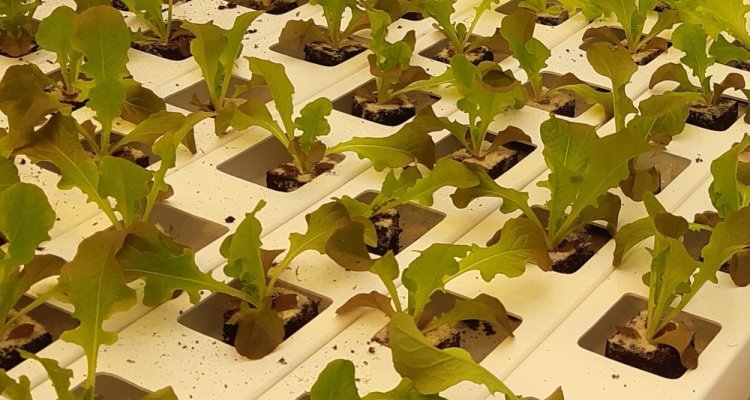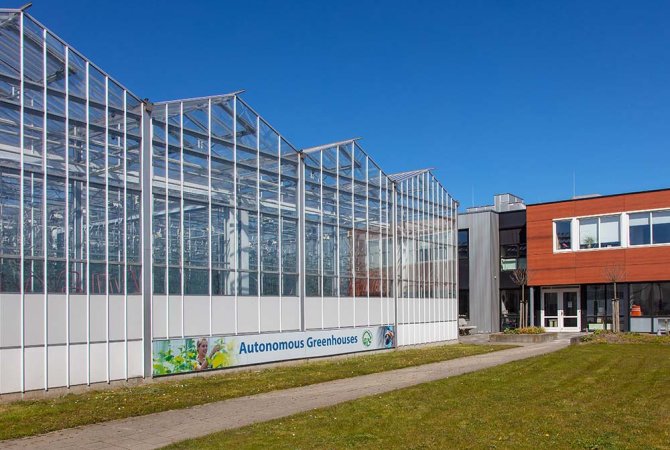
Generic article
The greenhouse growing experiment
In a practical greenhouse growing experiment, the 5 best scoring teams will grow a lettuce crop in two crop cycles of 6-8 weeks in 5 greenhouse compartments at WUR Bleiswijk fully autonomously.
Wageningen University & Research (WUR Bleiswijk) has a unique high-tech greenhouse facility with identical small (96 m2) compartments. All compartments have different actuators to control the inside growing conditions. Main actuators are: ventilation windows, 2 heating systems, 2 shading systems, artificial lighting, fogging for humidification, water input, nutrient mixture, CO2 input. All compartments are equipped with standard sensors to control the actuators through a standard greenhouse climate computer. Main sensors are: temperature, humidity, CO2, PAR light, pH and EC of fertigation water and simple RGB camera’s. All data measured and all control actions taken are available through a data interface.
Each team will have access to one compartment with its standard sensors installed (see above). Each team will be allowed to install additional sensors high resolution RGB, hyperspectral or thermal camera’s to monitor crop growth or any other sensors which they consider useful, before the experiment starts. No human measurements of crop parameters will be provided by the organizers, apart from measuring final harvest. The teams will have access to all relevant data via a data interface from their own compartment. The teams will have to develop fully autonomous algorithms and submit them to the organizers before the start of the second crop cycle experiment. These algorithms should be able to make choices with respect to the control settings, to remotely control crop growth.
Each team will be able to extract necessary data from the greenhouse compartment and couple it to their own fully autonomous algorithms in order to decide on the control settings for the next period. The control settings will have to be sent back automatically to the system (the greenhouse climate computer) in order to control the actuators automatically. Only the second crop cycle will count. The winner will be the team with the highest net profit at the end.
Our teams:
CVA
Anyone can grow!
Previously in the Online Challenge, we made up with the second place, and in the Hackathon, we ended up taking first place! It was a truly unexpected and exciting experience for all of us as a team. Though, this is still not the end of our story. Now, we are aiming at the real growing challenge, and working really hard to build flexible algorithms to adapt and learn diverse environments and conditions of a greenhouse and be able to make wise decisions to control the greenhouse.
Each one of us has a different background, from a grower to machine learning expert, robotics expert, software engineer, and full-stack programmer, but all of us have a common interest, which is to integrate agriculture and artificial intelligence. Our goal is to achieve autonomous greenhouse by applying AI technology so that anyone can grow with fewer resources and higher production!
Veggie Might
Unlock the Value of Digital Agriculture.
VeggieMight is an international team with experience lettuce growers from both China and Netherlands, data scientists from both the Netherlands and Ukraine, digital innovators and researchers from Wageningen University and Research. All members of VeggieMight team join Autonomous Greenhouse Challenge for first time, and we have to bridge the expertise of horticulture and AI by also overcoming the challenges of communication and coordination as we are located in different time zones and the full team never meet in person so far.
Luckily the we managed to have the majority of team members joined the Hackathon on site, we really had fun in the 2 days at Bleiswijk and great to entry to the growing challenge phase. We are happy that our team accomplished the task fastest in Hackathon and nominated as fair play team. We hope the growing challenge phase can further light our belief that AI could help to make the vegetable production much easier and enjoyable for all people in a sustainable way. We believe in us as a very diverse team to bring together the best of every world and unlock the value of digital agriculture.
Monday Lettuce
The realization of the future agriculture we envision.
In 2020, we formed a Digilog team with various organizations in South Korea and took 3rd place. But this year, we would like to participate with only our key partners to evaluate our technology. Furthermore, by interacting with different teams worldwide and testing our skills, we can establish new relationships and explore undiscovered opportunities.
Digital Cucumbers
We strive to become an indispensable part of the progress of Russian agriculture.
We really like the idea of a competition for automated greenhouses from WUR and Tencent. By participating in this competition we will not only contribute to the overall development of agriculture, exchange knowledge and experience with experts, but also inspire agrotechnological startups to develop and promote their technologies and ideas along with large corporations.
Koala
I have all the Koalifications.
Team Koala's ambition is to advance greenhouse growing with an intelligent automation technology that is scalable across farms, crops, and even more broadly across process-based manufacturing industries.

The results:
Follow the progress LIVE inside our greenhouses on our dashboard.